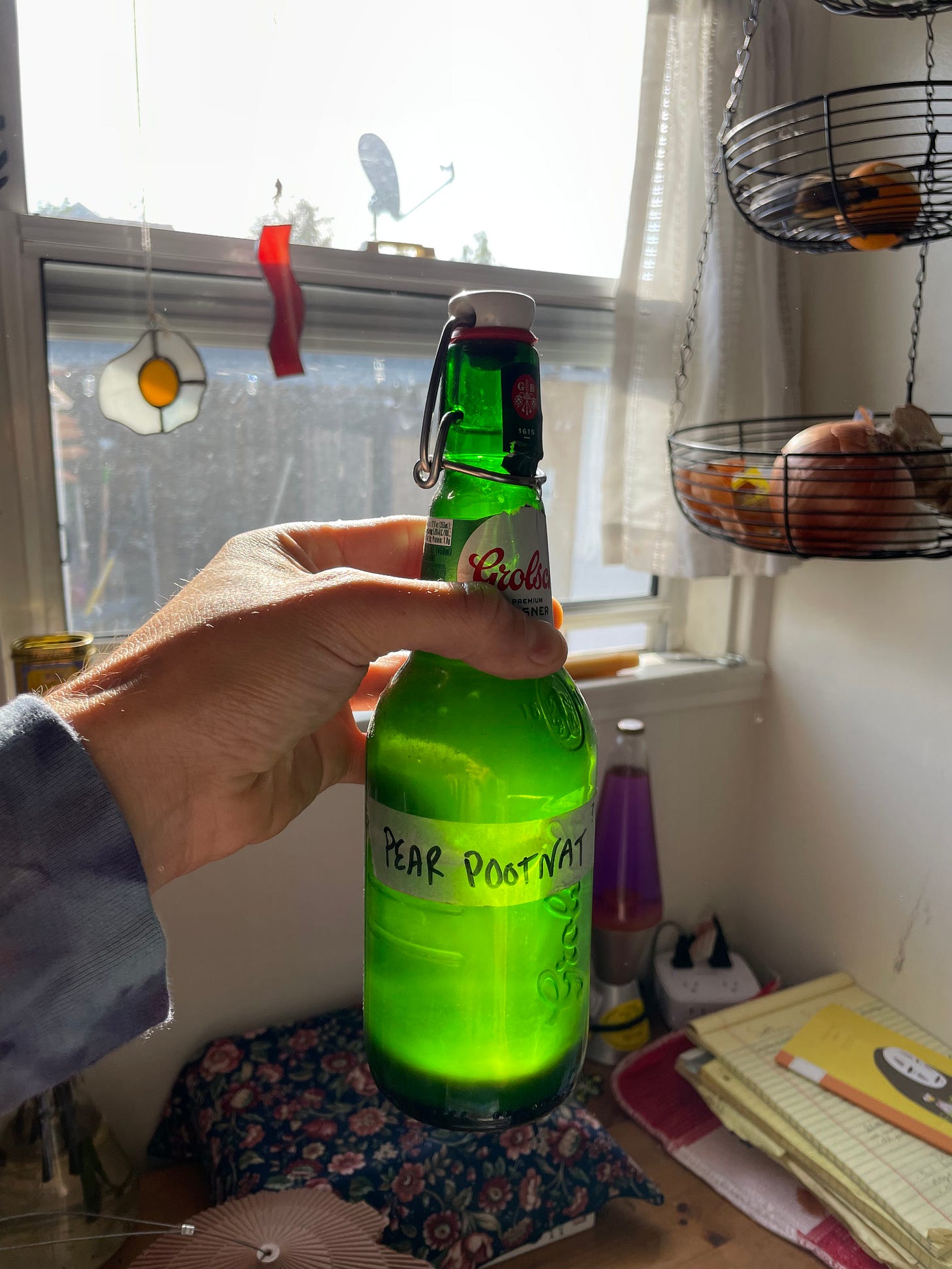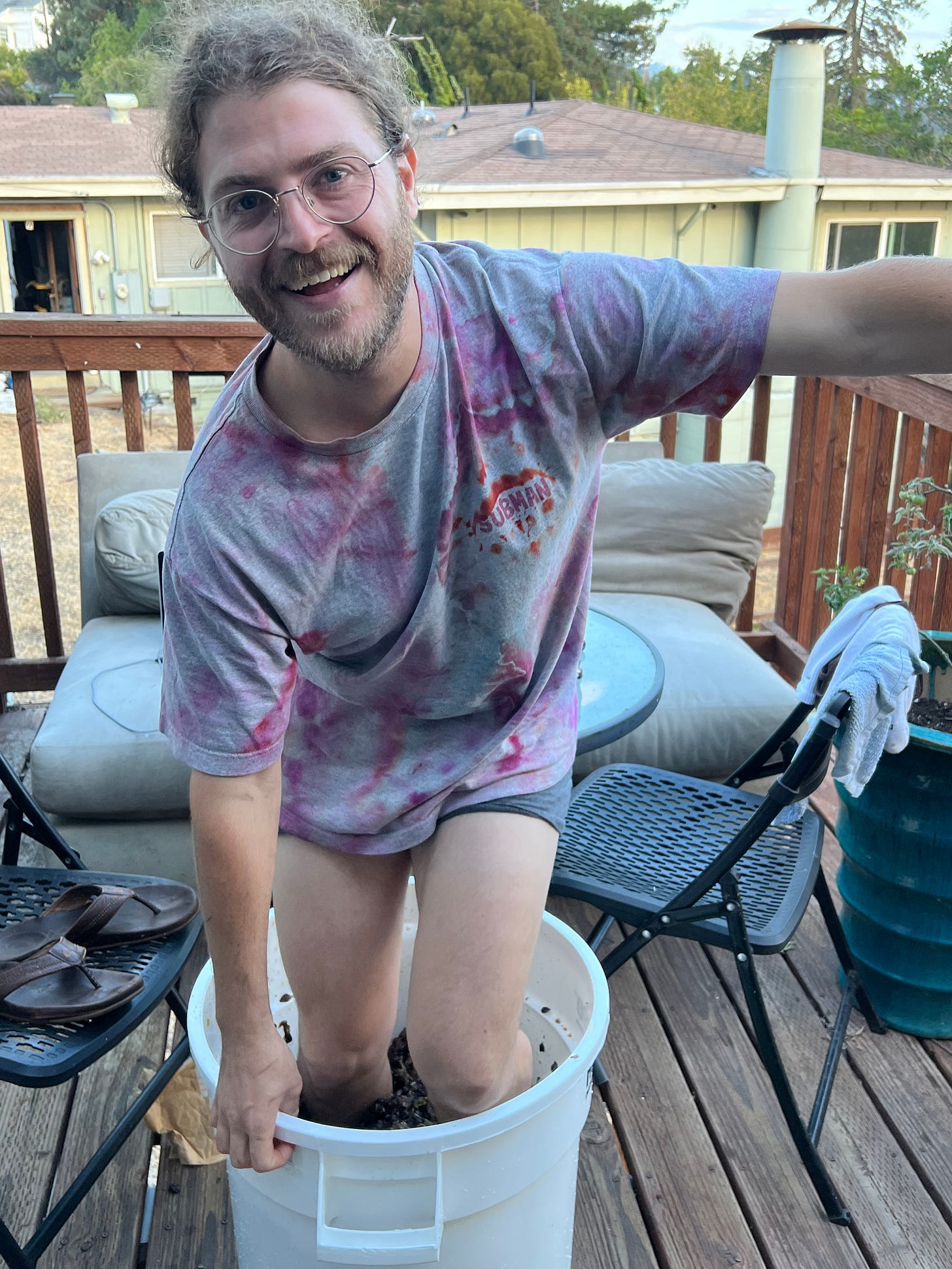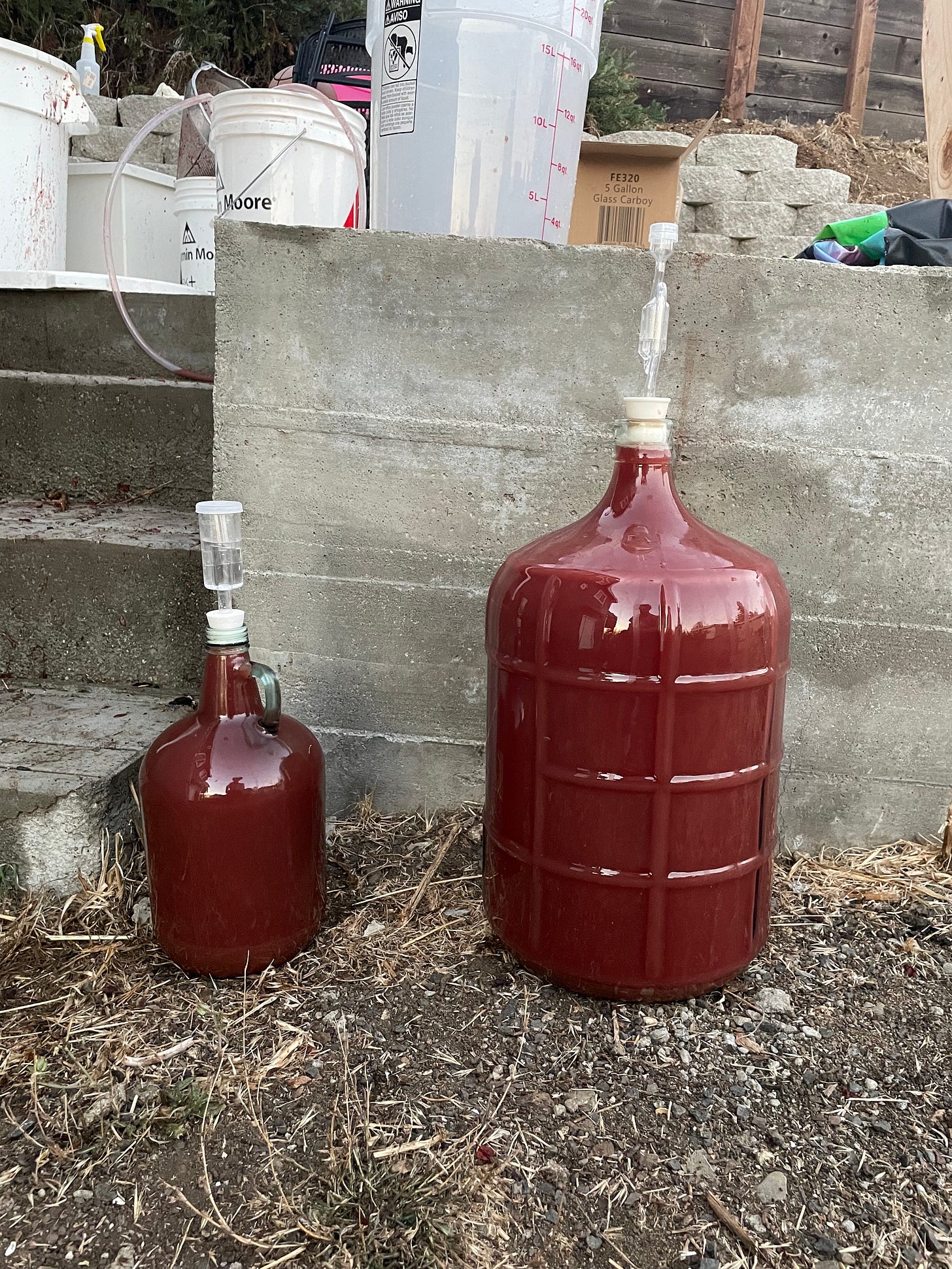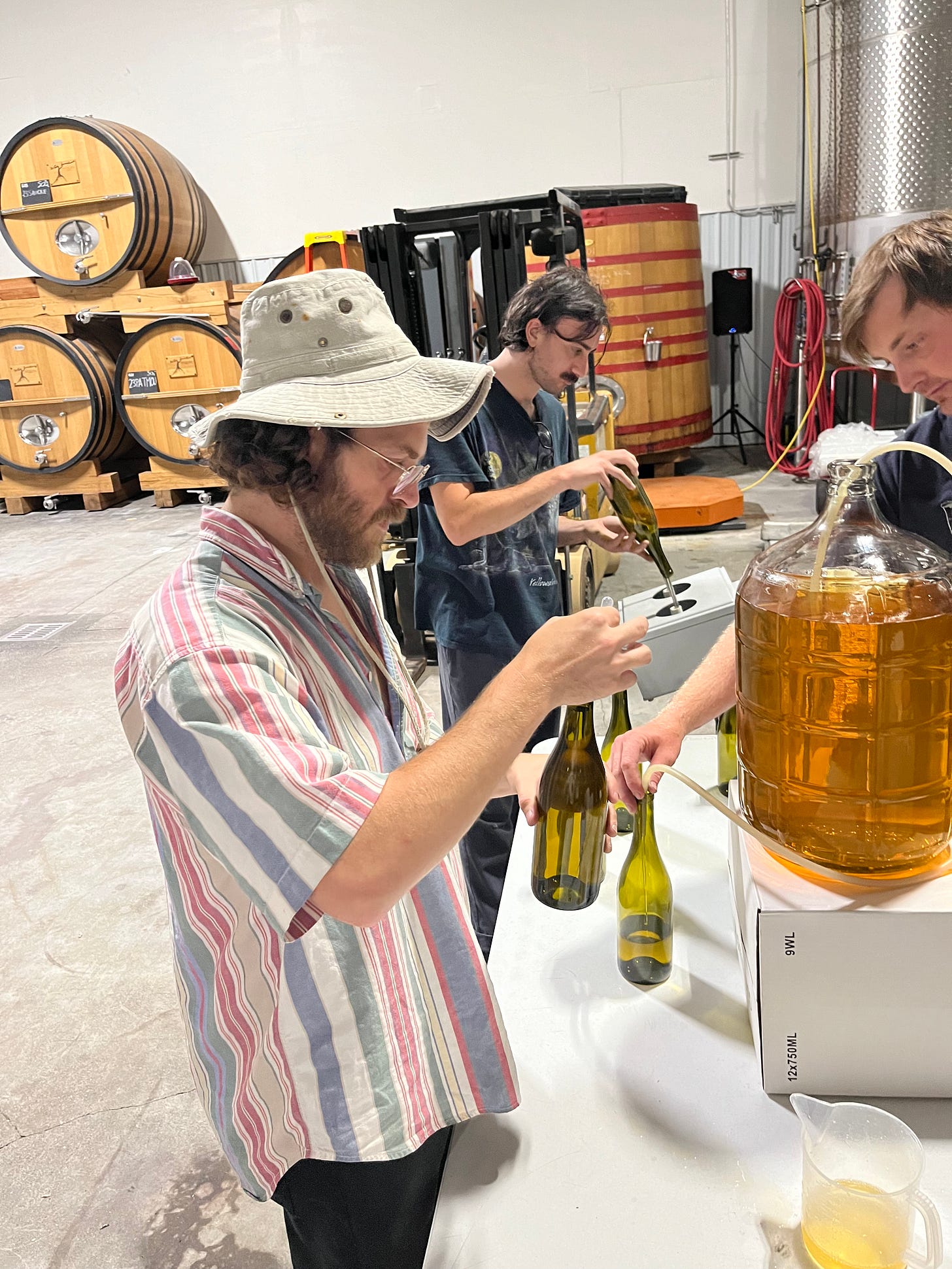My friend Ben has an ever-growing bucket list, which mostly includes things I’m not that interested in: going to the Hoover Dam (which we did five years ago, boring), Mount Rushmore (which we did four years ago, yawn), and swimming in one of those cages where sharks come up and say hello (which I will never do). A few years ago, after we’d driven a car through a big tree to cross yet another thing off Ben’s list, I realized something — I didn’t have a bucket list of my own. My bucket was empty.
I sat down and thought real hard (easier said than done), and eventually it came to me. There was at least one thing I wanted to do before I left this mortal coil: I wanted to crush grapes with my feet. This pedal desire was, I eventually gathered, part of a bigger, long-dormant goal of wanting to make my own wine. A goal that had been bubbling under the surface
I’ve been fermenting for about a decade, mostly using a technique I like to call “Sloppy Style” — no measuring, no sterilizing, just trusting your senses and your instincts. I’ve come to think of fermentation as a process that raw ingredients want to — under the right conditions — go through. Raw milk wants to culture itself, veggies want to acidify under salt water, and fruit juice wants to turn into alcohol (and then, if exposed to oxygen, vinegar). For some reason, though, alcohol fermentation has always felt a bit unintuitive and intimidating.
I have tried to make wine a handful of times in my life, with varying degrees of failure. My first attempt was eight years ago. Being the fearless young fermenter I was (i.e. not knowing shit from sandwich), I tried to make mead by adding a whole packet of bread yeast to honey water; I mixed it all up, strapped a balloon around the top of the container, and went on my merry way. Nobody told me I was supposed to use wine yeast. I came back a few hours later to find the entire gallon of bready honey water had blasted the balloon off, and explosively frothed itself out of the narrow neck of the bottle. My roommate laughed at me as I sponged down the countertops and kitchen walls. I tried making mead a couple more times, but after some time, discouraged, put alcohol fermentation out of my mind.
Then, in 2021, I met Barry Collins, an at-home winemaker and mad-scientist. Though some of his wines are untraditional (including a sparkly wine called Unicorn Pee, and a wine fermented from Capri-Sun), Barry does what I would call conventional at-home winemaking, meaning he uses sulfites to sterilize his fruit juice, then introduces yeasts and other additives1 to try and shape the outcome of the final wine. He very generously coached me through my worries, shared his methods, and introduced me to the equipment and ingredients I’d need. All the strange, powdered ingredients felt a bit overwhelming, but Barry made it all sound so achievable. Inspired by his confidence, and afraid to once again “fuck it up,” I decided to follow his process for making fruit wine.
After I talked to Barry, I set out on a cross-country road trip from New York to California in my van, “Poot.” A few miles outside of Austin, Texas, I stopped at a winemaking store and bought sulfites, a hydrometer (a little floating glass thingy that you put into a beaker full of juice/wine to measure sugar content), and some wine yeast; then, at a nearby Whole Foods, I bought a 2.5 gallon, plastic water jug and several incredibly expensive bottles of pear juice (I hate Whole Foods). And just like that, I had everything I needed to make my very own pear wine.
Later that day, at a beach on the Gulf Coast of Texas, I cut a ragged hole in the top of the water jug, emptied it out, filled it up with my pear juice, and added the sulfites2. A day later, in Corpus Christi, I added the wine yeast, and by the time I reached McCallen, Texas a handful of days later, the juice was well on its way to being fermented into alcohol. At a friend’s house in town, I tried to pour myself a taste, accidentally broke off the spout at the bottom of the jug, and lost about a liter of my nascent wine to their floor. Would you believe I’m the same Cody that exploded a bunch of mead all over my kitchen years earlier?
After a few more days of driving, the hydrometer told me that the yeast had fermented a majority of the sugar in the pear juice into alcohol; I pulled off on a dusty road in Big Bend National Park, and transferred the wine from the jug to a bunch of empty, swing-top Grolsch bottles that I’d dutifully drunk the night before. Spilled wine clumped in the dirt at my feet, but after about 10 minutes, I had bottled my first wine. I dubbed it: Pear Pootnat3. I dropped a bottle off at Barry’s in Tucson (tried a few of his wines, too, and picked up some more scary winemaking powders), then I kept heading west. A few weeks later, in San Diego, I opened a bottle. It tasted…. totally okay. But it was mine, I had made it. And I was hooked, stuck with the wine-making bug.
Still, I couldn’t help but feel a little weird using all these strange powders — it felt so far from the willy-nilly, fermenting-from-the-gut I’d been doing for years before that. In the back of my mind, I knew what I really wanted to make: natural wine. What is natural wine? There’s a lot of opinions out there (about growing practices, sulfites, etc.), but when I think of natural wine, I think of a wine that’s only ingredient is fruit. There’s something that feels natural to me about smashing up fruit, letting the wild, native yeasts gobble up the sugars, and creating a wine born out of its own inherent qualities. That’s what I wanted to make.
A few months after my road trip, feeling confident from my recent success, I tried to make a natural Cara Cara Orange wine. I left town for a few days, and came back to find my wine covered with a thin layer of white and blue mold. Failure. Disappointed, I took a step away from making booze for a bit. I knew that winemaking could be aligned with how I’d fermented in the past — after all, the only thing I needed was just fruit, time, and the right conditions — but I needed a little break.
Then, two years later, I had my bucket list revelation: I wanted to feel tender grapes squish between my toes. It was September, grape harvest time in California. I asked around, combed Craigslist, and eventually connected with Sam Rogers, a winemaker in South Oakland. They were buying three tons of Pinot grapes, and were open to me pinching off 100 pounds — enough to make 4-6 gallons of wine. When I arrived at their house, they had a U-haul pulled through their side gate, filled with two massive tubs of grapes; I’d never actually met Sam in person, and my first image of them was in a five foot tall fermentation tank, up to their ribs in grape mash and juice, sweating profusely and stomping away. Soon, I thought, that would be me.
The next day, at sunset, I stood on my balcony in a t-shirt and boxers with a 25 gallon food grade garbage can full of grapes. I hesitated. My toes were painted peachy pink, and I had a few healing cuts on my legs from a recent rescue mission to save an indoor cat that’d escaped from my house. But, I had to crush the grapes. It was my destiny. I sank my feet into the cold, squishy marble pit, gripping onto the sides of the trashcan as I pressed down, feeling the thin skins between my scarred, painted toes. For the next twenty minutes, I squished and squashed and video-called everyone I knew to show them what I was doing. Everyone liked it (thank god), and eventually, happy, and with sticky calves, I lugged the garbage-can-turned-fermenter downstairs, into my bedroom. I’d crossed the first item off my bucket list.
After my previous Cara Cara failure, I was nervous about risking my 100 pound grape investment on the “natural” wine method; I called Ben, who's been with me for my entire wine journey, and he reminded me that, long before I wanted to crush grapes, making a natural wine was the closest thing to a bucket list item I’d ever had. So, I decided to take the leap — this wine would be just grapes, and nothing more.
The next day, I checked on my juice. A large “cap” of skins had formed on top; I pushed it down with a ladle, and frothy bubbles emerged above them — fermentation! I tasted the juice. It was delicious, bright, sweet, and wonderful. Over the next couple days, I’d break up the cap about three times a day (to discourage mold formation), and continue measuring the declining sugar content using my hydrometer. As the bubbles continued to rise and the sugar content to sink, it seemed like I was on my way to my first natural wine.
Now a bit more confident, I started to feel like I could trust my fermentation intuition. On the third day, happy with the color of the wine, I decided to take the juice off the skins. I rented a 30 gallon fruit wine press from a local fermentation shop, and set up a pressing station outside my house. I sanitized all the vessels with Everclear, then rinsed with water, set a bucket and a fine-mesh strainer under the ledge that the press was on, and then I was ready. I used a blender to scoop the chunky grape mash into the press as the ruby red juice flowed out below. I filled up one bucket quickly, and started on another, stealing little spoonfuls every couple minutes to make sure the wine wasn’t getting too astringent from crushed seeds. It was the best grape juice I’d ever had, so bright and sweet.


Then I called a friend and asked him how tightly I should press the grapes. He informed me that I should NOT have pressed the wine this soon, and that the current color was so light that, if I took my wine off the skins this early, the final color would end up lighter than a rosé. Defeated and sighing, I undid the press, filled a cloth bag with some of the pressed skins and seeds, and put it back into the juice to extract more of their color and tannins. Once the bag was full, I sighed some more, and tossed handfuls of the remaining seeds and skins back into the wine, loose. Damn. I’d have to press it all over again in a few days… so much for my intuition. Still, over the next couple days, my wine seemed to be fermenting nicely
Then, after about a week, something bad happened. My wine started to smell like acetone. Danger, danger. I… how can I put this… completely panicked. I started combing through forums and calling winemaking friends, and eventually discovered that my wine and I were experiencing Volatile Acidity, a dreaded flaw that can creep into fermenting wines for reasons that are beyond me4. The only solution, I learned, was to add sulfites, and to move the wine into an oxygen-free environment. Reluctantly, and a bit sadly, I added a camden sulfite tablet to my wine. The ingredient list for my born-out-of-its-own-inherent-qualities natural wine had now doubled.
The next day, it was time to get it out of the trashcan and into the barrel. I undid the bag of seeds and skins, and did my best to “press” them through the fine mesh strainer (along with several bits of my knuckle skin). Then, using a syphon and a process not so dissimilar from stealing gasoline, I transferred my beautiful, if flawed, Pinot into two vessels: a 5 gallon and a 1 gallon carboy. I put them both under airlock, hefted them into my fermentation dungeon, and tried my best not to think about them.
A month or so later, I checked back in. The lees — dead yeast and other byproducts — had settled to the bottom of the containers, so it was time to again rack the wines to a new container. I did so, spilling only a few cups onto my bedroom floor. After leaving the lees behind, I had five gallons of homemade wine — enough to fully fill up my biggest carboy. I gave it a taste. Tragedy. It still tasted (and smelled) like acetone. I sighed, put it back into my fermentation dungeon, and closed the door. Maybe time would fix the flaw (and heal the wound to my confidence).
That door stayed shut for almost a year and a half. Eventually, as I was starting to think about leaving Berkeley, I worked up the nerve to bottle it. I added some more sulfites (a common practice before bottling) and brought my five gallons of Pinot to Bedrock, a friend’s winery in Napa. They very graciously helped me bottle my wine and cider (using their fancy equipment, including an Argon injector that helps prevent spoilage), and I thanked them with a baby weed plant, a melon, and a few bottles of my stinky wine. We all helped ourselves to a taste, and my winemaking friend informed me that my wine had become oxidized (from sitting around for too long before bottling) and did indeed have a slight Volatile Acidity flaw. He said it would make a good “party wine.” I smiled, dead in the eyes. We filled up a few cases of magnums, clarets, and standard bottles. My first (not so) natural wine was complete and ready to age, flaws and all.
I opened my first bottle (a magnum) about six months later, at a big goodbye dinner I threw at Chez Panisse before I left Berkeley. It was the fourth or fifth bottle of the night, so I can’t remember it too well; but, everyone drank it, so it couldn’t have been too bad. Then, just this week as I set down to write this, I opened a bottle for myself, aged about a year and a half.
I poured a glass. Like my friend said, it had oxidized — the color was now similar to the brown-orange-red haze of Los Angeles dusk in an 80s movie. I took a sip — tart and red like a raspberry, a bit tannic and… yes, sadly, a touch of acetone. But the flaw had softened with time. And after about an hour, the wine actually seemed to have softened even more, and was now tasting like a watered down jolly rancher. It tasted good to me, but, then again, I was half a bottle deep by that point.
Looking back, I’m proud of my wine. It’s imperfect, but it got me back to my fermentation roots. From the trash can, to the nail polish, the premature pressing, and the last minute pivots, it is definitely a Sloppy Style Pinot. Plus, I certainly enjoyed it more than Mount Rushmore.
He’ll add acid (of which there are various types — malic, tartaric, citric…), tannins, and for his famous Unicorn Pee wine, edible glitter.
The sulfites eliminate native bacteria in the juice, thereby creating a blank canvas for the added wine yeast to convert the juice's sugars into alcohol.
This wine was technically a pet-nat, as I bottled it while it still had some natural sugar left in it; this technique allows the rest of the fermentation to take place under pressure, which in turn traps the carbon dioxide created during fermentation, and makes the wine lightly carbonated.
My understanding at the time was that it might have to do with the temperature it was fermenting at, or how long and how much it was exposed to oxygen.










Definitely had to look up this unicorn pee wine and then learn that there are other wines with glitter! What a wild ride and honestly, successful ride. Might go make some wine now.
I love your writing!